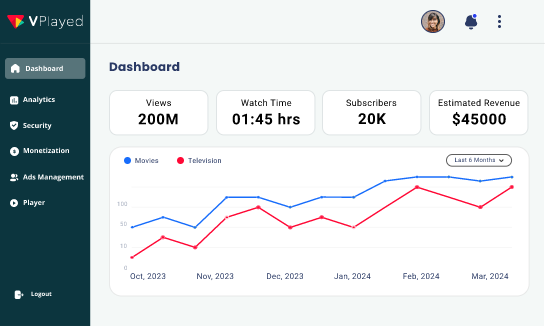Start and Grow Your Education Streaming Platform With 1000+ Features & 10+ Revenue Models.
Book a Free DemoHow To Build An Educational Video Subscription Platform? From A to Z
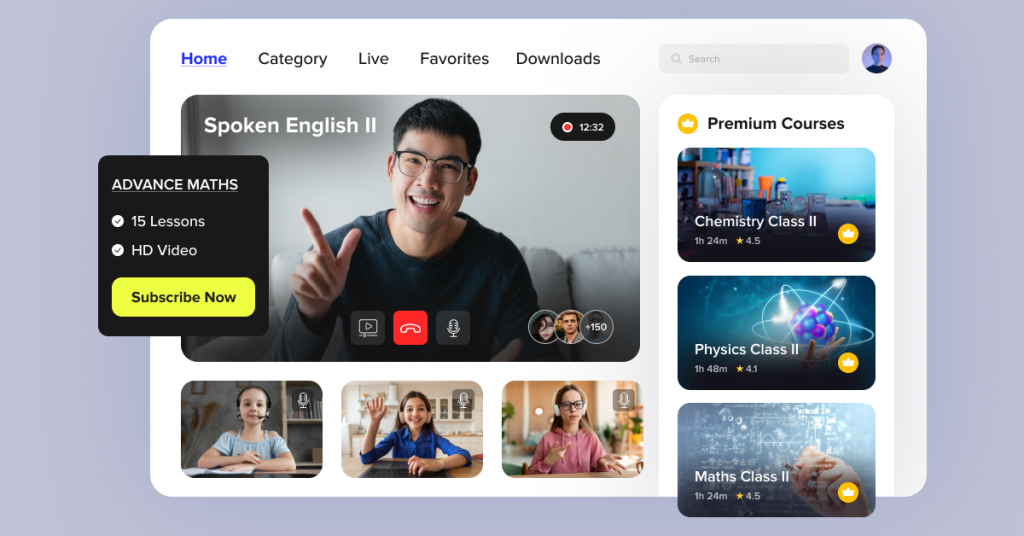
Summarize this article via
Platforms like Coursera, Skillshare, LinkedIn Learning didn’t just happen overnight. They saw a sizable gap, built online systems, and made money from online learning.
And now, they are ruling the eLearning industry.
Online learning is at the heart of its peakdom, and no better time than now to build an Educational Video Subscription Platform if you have plans to. See, the stats speak for themselves.
EduTech brands that take practical steps now are actually setting themselves up for sustained success. But here is the catch – Having an online education platform is not just about recording and uploading lessons.
Because, people don’t just buy courses, they invest in educational experiences that empower them. And this is not just limited to the traditional education models.
- Fitness trainers,
- Corporate coaches
- Online tutors,
- Niche experts, etc.
Anyone with knowledge can build an educational video subscription platform by teaming up with a VOD Platform Builder. But if you are wondering – why a new platform when you have so many options out there?
Unlike third party platforms, having your own platform gives you complete control over:
- Pricing,
- Branding,
- And data.
The best part? You can make this into a scalable platform to earn money online as there are many video monetization models available like SVOD, TVOD, AVOD, and more to sell videos online.
The opportunity to grow is here. The demand is growing.
So why wait?
Let’s explore how to build a bespoke online video education platform and the best ones who can bring your vision to life.
- Fully Customizable
- Lifetime Ownership
- On-Premise/On-Cloud
- 100% White-label
- Zero Revenue Share
- Hire Developers
Table of Contents
🔊Why E-learning Subscription Platform Is Popular In 2026?
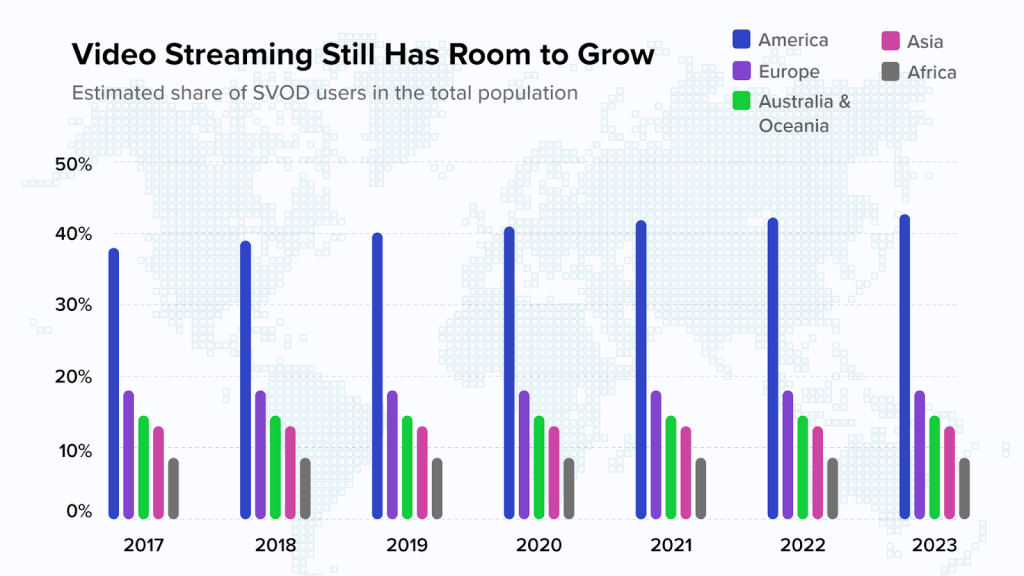
When we talk about today, many educational institutions are offering online classes to help students complete their vocational training and earn certifications.
More than 60% of internet users have found e-learning beneficial because it fits well with their lifestyle.
For example, Udemy, a well-known online video education platform, has over 20,000 experts teaching 12 million students — according to Skillscouter.
Education video subscription services are changing how people learn by offering access to a vast library of on-demand videos for learning with live streaming, video playback, anytime access and with interactive elements that can be learnt through platforms like Muvi, and Zoom.
Educational institutions and companies are increasingly moving their training and induction programs to online video platforms.
In the United States alone, corporate training through e-learning modules has captured over $100 billion in market share.
Moreover, E-learning subscription platforms allow easy access to educational content and training materials through websites or apps.
Learning on an online video platform gives people the flexibility to learn at their own pace and expand their knowledge.
In short, building an educational video subscription platform offers a great opportunity for content creators to effectively monetize their videos.
One can charge a subscription fee, offer pay-per-view options, or use ads to generate income from their educational videos.
It is also a great way for content creators to monetize their videos for educational services by charging a subscription, pay-per-view, or using advertisements to generate revenue.
🔊Which Features should be present in an Educational Video Subscription Platform
An educational video subscription platform should make learning easy and effective by offering a user-friendly, easy to navigate interface, high quality video streaming, online interactivity elements, deep video analytics, secure content, and integration with other learning management systems along with features like live streaming, community engagement, and performance assessment tools in-built.

1. Easy-to-Use and Powerful Video CMS
When you build an educational video subscription platform, it is important to have a user-friendly and powerful Content Management System (CMS).
This system should make it simple to upload, store, organize, and access video content for both creators and users.
In addition to that, having global servers with a reliable Content Delivery Network (CDN) will help stream videos smoothly for users worldwide.
2.Set Your Own Pricing
Creating a white label vod platform allows you to set your own pricing for your content and services.
You have the freedom to charge what you think is fair, with no strict rules. This flexibility means you can adjust your prices as needed and sky’s the limit.
3.Payment Integration
As e-learning continues to grow, having secure and easy payment integration is essential. To build an educational video subscription platform without a strong payment gateway is no joke.
Your educational video subscription platform should support various payment methods. This includes one-time payments, recurring payments, and auto-pay features.
This will guarantee a smooth and secure transaction process for your users.
4. Keep all your profits
When you create your own video subscription website, you get to keep 100% of your earnings.
Unlike other OTT platforms that take a commission, all the subscription fees go directly to you. This allows your institution to fully benefit from whatever revenue is generated.
5. High-level Security for Content
Security is of utmost importance when you build an online video education platform.
Protecting your content with strong security measures reduces the risk of hacks and ensures that your videos, user data, and payment information are safe from unauthorized access.
6. Real-time Analytics to Track Students Engagement
Having real-time analytics lets you see how students are interacting with your content.
This feedback helps you understand which videos are most engaging and where improvements can be made. You can use these insights to update your content and keep your audience interested.
7. Supports VOD and Live Streaming
There is no denying that your educational video subscription platform should support both Video on Demand (VOD) and live streaming.
This flexibility allows you to offer pre-recorded videos and live classes.
Additionally, making live-streamed sessions available for replay will help students to review the material whenever they need it.
8. Monetize Video And Combined Subscriptions
E-learning platforms allow you to generate income by offering different types of subscriptions, such as weekly, monthly, or yearly plans.
You can also explore pay-per-view options and use ads as additional revenue streams.
Some VOD platforms supporting educational content integrate multiple monetization models, enabling flexible and scalable VOD streaming for both students and professionals.
9. Scalable Revenue Generation
Your content can continue to generate income over time with minimal updates to keep it relevant.
For example, you can offer exclusive content for members or run promotions to attract new subscribers.
The basic thumb to increasing revenue is providing high-quality, unique content that keeps viewers coming back.
🔊How to Build Your Own Educational Video Subscription Platform?
Coming to the main picture here, How to make an educational video subscription platform and it’s easy if your study the educational video platform market and follow the below steps,
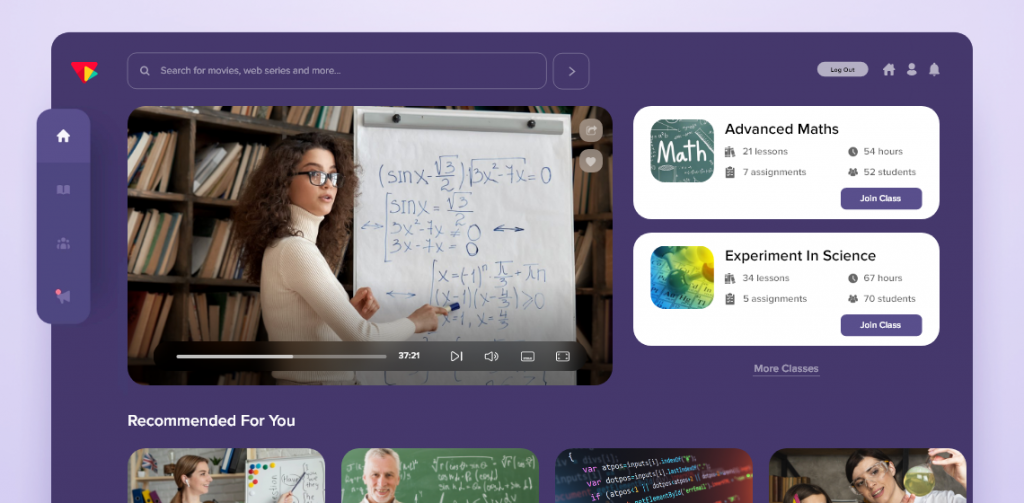
1. Create High Quality content for your Educational Platform
Most important, you should focus on creating videos that can address the challenges within your niche. Get in touch with subject matter experts to build credibility and ensure your content is more than just educational – it must be engaging too!
- Use professional grade mics,
- Clear visuals, and editing software
To maintain high quality. And structure your online lessons logically by building upon each lesson so that users feel the learning is linear and progressive.
Don’t make it fully theory – Include elements like slides, infographics, and animations to ease and enhance complex topics to keep learners engaged.
2. Build your Educational Video Subscription Platform
No matter how valuable your content is, a strong platform should stand as its backbone!
Design in such a way that its user friendly, interactive and intuitive. The UI should be easy for users to navigate and find relevant videos based on their interests. Implement features like:
- User profiles,
- Progress tracking,
- Personalized recommendations.
Furthermore, allow space for interaction via discussion forums or peer reviews to increase community engagement.
An educational learning platform that combines great content and a smooth, engaging UI will help retain users and also bring in new ones.
3. Implement Adaptive Bitrate Streaming and Video Transcoding
Video transcoding allows your videos to play the same way across different platforms, devices and internet speed. You can use a strong video CMS and a reliable transcoding tool that adjusts the video quality based on the internet connection speed of the video.
Looking To Build Your Own Education Streaming Platform?
Start and Grow Your Video Streaming Service With 1000+ Features & 10+ Revenue Models.
Highly Customizable
Life Time Ownership
Own 100% of Your Revenue
Full-Branding Freedom
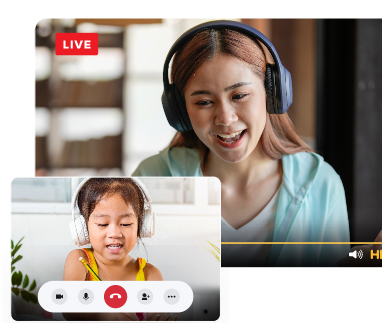
Doing so, this:
- Prevent video buffering,
- And keeps audiences engaged.
And adaptive bitrate streaming automatically shifts the video quality in real time for smooth playback, whether it’s on PC or a mobile device.
By video transcoding in multiple platforms, you give online learners a superior viewing experience irrespective of their location or device.
4. Add Subtitles, Video Chapters, and Additional features
Subtitles can take your lessons to across the world, bring in new viewers, and increase engagement,
And breaking down lessons into video chapters can let users jump into specific sections of your videos to make navigation easier.
You can make it more appealing by adding quizzes or assessments after each section to test understanding of learners.
Additional, interactive elements like polls or discussion broads will motivate learners to apply what they learned.
Apart from boosting user interactivity, these features also enhance learning outcomes as they are more likely to retain learnings when they engage w/ what they are learning.
5. Leverage Video Embedding or Create a Custom Portal
While embedding videos on your education platform is a plus, it can create more impact if you create a custom portal based on the lessons and subjects. Because a custom portal can be that centralized space where all learners can:
- Access their educational resources,
- Track their progress, and
- Partake in community driven activities.
They could be discussion forms, certifications, or Q & A sessions w/ experts.
An exclusive custom portal will provide a branded experience that will increase the user’s connection to the content and bring in a sense of belonging.
6. Integrate with Strong Security for Content Safeguarding
Make no compromises on the security part! Have strong video encryption protocols to safeguard user data and bring in digital rights management to prevent unauthorized access or downloading of the videos.
- Adding on, secure payment gate aways and multi factors authentication ensure all the finances and user logins are safe.
- Periodically check for security breaches and use dynamic watermarks on videos to deter piracy or their attempts.
Building a strong security does more than just protecting your content, they build trust with the platform viewers to ensure safe communication for both learners and creators.
7. Brainstorm How to Sell Videos Online
There are multiple ways to earn money with videos. But what video monetization model you are going to choose makes the difference between winning and losing. You can design:
- Flexible subscriptions plans like monthly, quarterly, or annual options,
- And give different tries of access, depending on user needs.
Maybe provide a limited free trial to let potential subscribers analyze your content lessons. And for those who choose premium tiers:
- Offer exclusive content,
- Certifications upon completion,
- Live streaming sessions with instructors.
Choose a video monetization model based on the type of content and build a sustainable business model by rewarding subscribers with additional value.
With interactive sessions included in your premium plans, you also get the opportunity to make money with live streaming while enhancing learner engagement.
8. Promote your Content in All Possible Ways
Tell the whole world about the educational platforms and the knowledge offered. Here are some tips in both organic and paid ways:
- Build a SEO driven content strategy
- Link blog posts and social media content
- Create engaging teasers / mini courses to reach new audiences
- Collaborate with relevant influencers
- Shoot testimonial videos of past learners
And importantly, make your content shareable and ask the audience to do the same by sharing the achievements or success stories. A well built promotional strategy will help grow your audience and increase success rate.
9. Strong CDN and Smooth Video Delivery
Having a strong content delivery network [CDN] gives fast loading speeds, irrespective of the user’s location.
Using a robust video CMS platform allows you to compress video files to reduce buffering while maintaining the same video quality, especially for mobile users with limited bandwidth.
Periodically test your educational platforms performance to address the loading issues that could affect the overall performance and user experience.
And mobile optimization ensures your content is accessible on all appropriate devices to allow users to continue their learning uninterrupted, even on the go.
10. Keep Experimenting and keep Evolving
Always track metrics and video performances!
Doing this is essential to get an understanding of what is working and what isn’t. Leverage analytics tools to monitor:
- User engagement,
- Watch time overall,
- And content preferences.
Pay attention to where audiences are dropping off or which segments are getting more traction and refine content accordingly. Adding on, you should regularly review to:
- Adjust marketing campaigns,
- Subscription models online,
- And even course offerings.
With data backed decisions, this approach allows you to continuously improve the user experience and platform effectiveness, relevancy over time.
🔊Conclusion
We hope this article has provided you with a clear understanding of online video subscription platforms and the growing opportunities in the e-learning industry.
If you’re ready to launch your educational video subscription platform, consider reaching out to VPlayed to create a VOD website tailored for e-learning and get started quickly.
We can help you launch your platform faster with a 100% success rate.
Moreover, building an educational video subscription platform can set you apart and offer a steady stream of income.
Any day, if you are looking to share knowledge, provide training, or offer specialized content, creating your own platform puts you in control and allows you to reach a broader audience.
- Request Demo Book a Live, Personalized Demo
- Contact Sales Reach Out to Our OTT Experts
Frequently Asked Questions (FAQs):
1. What is an educational video subscription platform?
An educational video subscription platform is an online service where subscribers pay a recurring fee to access a collection of educational videos and resources. The platform is capable of offering a variety of content like courses, tutorials, lectures, and documentaries on different subjects or industries.
2. What are the key features of an educational video subscription platform?
The key features of an educational video subscription platform include user registration and login, content management, video streaming and hosting, subscription management, payment integration, user profiles, search and filtering options, progress tracking, user feedback and ratings, and analytics for reporting.
3. How to build an educational video subscription platform?
To build an educational video subscription platform, define your platform needs, choose the right technology, and develop systems for user registration, content management, and payments. Integrate video streaming, set up subscription management, and ensure security. Design an easy-to-use interface, then launch and promote the platform to attract subscribers.
